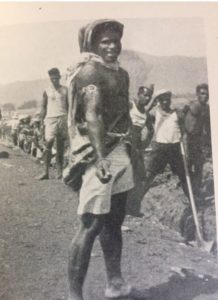- Author
- A.N. Other
- Subjects
- Naval Aviation, History - WW2, Infrastructure and Facilities
- Tags
-
- RAN Ships
- None noted.
- Publication
- December 2022 edition of the Naval Historical Review (all rights reserved)
By Rohan Goyne
This story complements an article in the June 2022 edition of the Naval Historical Review concerning the wartime construction of airfields on Norfolk Island and New Caledonia. Department of Main Roads employees were contracted to build these facilities as no other experienced workers were available at the time. Those involved were entitled to the Civil Service Medal in recognition of their contribution to national infrastructure.
The author contributed to Ian McNamara’s national ABC radio program in 2021 about the role of DMR on the 80th anniversary of these events. The story of the DMR is also to be found in his most recent e-book Home Front – a Country at War.

I only became aware of the stories of the efforts of the NSW Department of Main Roads (DMR) in construction projects in Northern Australia and overseas during the Second World War with the acquisition of a copy of the book Bulldozer by Michael Terry, written in 1945.The cover of the book is shown at right. This article continues my series on the home front economy during World War II which includes articles in the Commonwealth War Book and the production of DH gliders in Sydney during the early years of the war. The intricacies of the domestic war economy to support the country’s armed forces have been sadly neglected in recent writings about Australian military history.
Indeed, the NSW State Archives holds only a small collection of photograph albums from the DMR collection which were themselves a collection of workers’ ‘happy snaps’ rather than official photographs specifically commissioned by the DMR to document its work in the Second World War. So the archival history of the DMR’s work in World War II is scant at best. Even Michael Terry’s papers held in the National Collection at the National Library of Australia do not cover his commissioning and writing of Bulldozer, to the great disappointment of this author.
A subsequent call by the author for privately held primary source materials on Ian McNamara’s Australia All OverABC Sydney national radio program produced many sources, some of which have only been made public now and have been included in this article.
In 1941 the DMR was engaged by the Commonwealth Government to build roads and airfields in the Northern Territory and Far North Queensland. In 1941 it was also engaged by the United States (US) Government to build an airfield on Norfolk Island, and jointly by the US Government and the Free French Administration to build an airfield on the French territory of New Caledonia.
The DMR was contracted to build these significant civil engineering works because: firstly, it had the trained workers; secondly it had the heavy equipment (bulldozers and other items of road plant) within its organisation which were in short supply in the Pacific theatre; and prior to the commencement of the war it had a track record of successfully constructing large public works projects. Its civilian workers served overseas and in the then operational areas in Australia for the duration of the war. This article will concentrate on the overseas deployment of the NSW Government DMR civilian workers to build an airfield in New Caledonia at the height of the Japanese advance in the Pacific theatre.
The DMR was contracted to build an airfield in New Caledonia at Tontouta in May 1941. A photographic survey of the island had determined that there were only three sites on the whole island suitable for an airfield, one of which was Tontouta, located 56 kilometres from Noumea.
The magnitude of the task given to the DMR in New Caledonia was accurately stated as: ‘To set-up in New Caledonia, a self-contained unit with its own spares and workshop, able to recondition plant.’ This was the peculiar task of those who had never undertaken a project in a foreign land, especially in a war when shipping to and from the homeland was scarce, irregular and risky.

The site of the airfield was only 2.4 m above sea level, so 12 kilometres of perforated steel pipes was laid to provide drainage for the site. The runways were constructed with 81,500 cubic yards of gravel processed from the Tontouta River located 6.4 kilometres away. The runways were then surfaced with tar obtained from the Nickel Company in Noumea.
Both runways were 45 m wide, one surfaced for 1524 m, the other for 1831 m, intersecting at an angle of 82 degrees. The runways were designed to service some of the largest bombers used in the Pacific, namely the B17s and B24s. Ultimately both types operated from Tontouta and other later airfields established on the island. The airfield was handed over to the US for operations in March 1942.
The DMR had constructed a fully functioning airfield, effectively in the forward operating area, without any prior experience in airfield construction and within eight months, which is a significant achievement. It is a testament to adapting to a challenge with the resources within the domestic economy. Finally, it may be worthwhile for any remaining members of the DMR or their descendants investigating if they may be entitled to any medals for their service overseas in New Caledonia and/or Norfolk Island in 1941-42.




